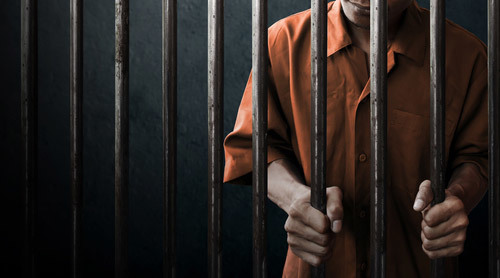Abuse of inmates and prisoners can be a civil rights violation. Victims may have grounds to bring a civil rights lawsuit with lawyers who help prisoners such as the civil rights lawyers at the Shouse Law Group. If successful, the abused inmate(s) could recover money damages. The lawsuit can also force a policy change that prevents future abuse.
1. What are common types of inmate abuse in jail?
Inmate abuse is far from unheard of. Inmates can be abused by:
- prison guards,
- the prison facility, or
- other inmates at the correctional facility.
Regardless of the cause, the jail can be responsible for the abuse.

Civil rights attorneys can help victims of prison abuse and jail neglect to file a civil rights lawsuit.
Common kinds of physical abuse or neglect from prison staff and corrections officers include:
- excessive use of force (“excessive force”)
- beating inmates
- kicking inmates
- using tasers or pepper spray
- overuse of restraints, like handcuffs
- punishing prisoners out of spite
- destroying an inmate’s property without cause
- verbal abuse, including humiliation and racially-charged language
- sexual assault / sexual abuse
- ignoring cries for medical attention
- jail death
The prison facility can be abusive if it:
- denies prison inmates adequate medical care (“medical neglect”),
- is overcrowded,
- excessively imposes extreme isolation, like solitary confinement,
- has plumbing problems,
- is uncomfortably hot or cold,
- has rodent infestations or is unsanitary,
- has unhygienic conditions, or
- does not release prisoners when they are eligible for release.
The jail can also be responsible for failing to prevent abuse by other inmates. Jails can be liable for not taking steps to prevent or stop acts of:
- rape,
- sexual assault,
- beating,
- violent crime,
- stabbing,
- gang fights, or
- executions.1
When this abuse serves no purpose, it can violate a prisoner’s rights. Luckily, an inmate rights attorney near you can help seek compensation for damages when abuse occurs.

Inmates in the prison system have constitutional rights under federal law. A prison abuse attorney can help.
2. What rights do inmates have?
Even in jail, inmates still have constitutional rights under federal law. When they are violated and the jail fails to protect the inmates rights, a lawyer who sues jails near you can help. In jail, the most important rights are:
- protection from cruel and unusual punishments under the Eighth Amendment,
- the prohibition against unreasonable searches or seizures under the Fourth Amendment,
- due process rights under the Fifth and Fourteenth Amendments, and
- equal protection under the Fourteenth Amendment.
The prohibition against cruel and unusual punishments can protect inmates from prison abuse. It deters prison officials from certain outrageous conduct. It also gives prisoners rights against abusive environments. Inmates can invoke those rights when:
- the prison is so overcrowded that it holds nearly twice as many inmates as it was designed to hold,2
- prison officials ignore requests for medical care for medical conditions,3
- they are punched and kicked for no disciplinary reason,4 or
- a prison guard attempts to sexually assault or rape them.5
Prison officials can abuse inmates by seizing them or searching them. The Fourth Amendment’s prohibition against unreasonable searches and seizures can protect inmates if the conduct served no other purpose than the abuse. Inmates can invoke their Fourth Amendment rights if:
- cell searches are used as a form of abuse,6 or
- prison guards strip search them excessively or in a group.7
Due process rights protect prisoners, too. These rights require that hearings be held before a prisoner is deprived of their:
- life,
- liberty, or
- property.
Due process protects prisoners from the following kinds of prison abuse:
- stripping a prisoner’s good-time-work-time credits without a hearing,8 or
- extended periods of solitary confinement without a meaningful hearing.9
A prisoner’s equal protection rights protect them from discrimination. Prison officials cannot target inmates for abuse because of their:
- race,
- gender,
- sexual orientation,
- religion, or
- national origin.
If prison abuse violates one of these rights, the victims can invoke their legal rights. They can pursue legal recourse with lawyers who sue jails for prisoners in these instances where constitutional rights have been violated.

An inmate can invoke their rights and pursue legal recourse.
3. What to do if an inmate is being mistreated in California?
Prison abuse can violate an inmate’s constitutional rights. The inmate can invoke their rights and pursue legal recourse. They can:
- file a complaint with the prison,
- file a federal civil rights lawsuit using 42 U.S.C. § 1983, or
- file a civil rights lawsuit in state court.
Those civil rights lawsuits can lead to 2 kinds of remedies for the victimized inmate:
- injunctive relief, and
- monetary damages.
Injunctive relief is easier to recover in a civil rights lawsuit. Lawsuits that pursue an injunction can get a court to order the prison to:
- reduce overcrowding,
- fix unsanitary conditions that rise to the level of abuse,
- fire abusive prison guards and jail officials or transfer them elsewhere,
- change its policies that allow inmate-on-inmate abuse, or
- take other actions necessary to rectify the abuse and prevent it from happening, in the future.
Monetary damages are more difficult to recover. These damages would compensate the abused inmate by paying for his or her:
- medical bills,
- pain and suffering, and
- violated civil rights, also known as presumed damages.
They can also include punitive damages, too. These damages are meant to punish the prison guard or facility for their wrongdoing.
To recover monetary damages, inmates must overcome the qualified immunity defense. This defense protects government officials from lawsuits over their conduct while they are on the job.
4. Why call a jail abuse lawyer who helps prisoners?
A jail abuse attorney can help by gathering evidence of the abuse and advocating on the victim’s behalf.
Finding evidence of an abusive prison environment is not easy. The Department of Corrections is in control of everything that happens inside of its walls. Collecting evidence is difficult and sometimes even risky. Prison officials raise as many obstacles as they can to cover damning evidence.
Even after enough evidence has been gathered to support a lawsuit, filing it is difficult, too. Civil rights lawsuits face numerous procedural obstacles. This is especially true for lawsuits that demand monetary damages. That compensation would come from the government. Because the lawsuit would recover taxpayer money, barriers are raised to make it more difficult to win.
Lawyers who help prisoners, such as the prison abuse lawyers at Shouse Law Group, can help abused inmates by handling these problems for them.
Have you, a family member, or a loved one been hurt in state prison or county jail? Contact our personal injury attorneys for a free case evaluation today.
See our related articles about police brutality and police officer misconduct and suing law enforcement.
Additional reading
For more in-depth information, refer to these scholarly articles:
- Marginality or Neglect – Women & Criminal Justice.
- Women in Prison – Women & Therapy.
- Causes and correlates of prison inmate misconduct: A systematic review of the evidence – Journal of Criminal Justice.
- A Right without a Remedy: Sexual Abuse in Prison and the Prison Litigation Reform Act – Harvard Civil Rights-Civil Liberties Law Review.
- Differences in inmate-inmate and inmate-staff altercations: Examples from a medium security prison – The Social Science Journal.
Legal References:
- See generally, ACLU, “Annual Report on Conditions Inside Men’s Central Jail,” (May 6, 2010). See also California Penal Code 147 PC – Inhumanity to prisoners.
- Brown v. Platta, 563 U.S. 493 (2011).
- Estelle v. Gamble, 429 U.S. 97 (1976).
- Hudson v. McMillian, 503 U.S. 1 (1992).
- Schwenk v. Hartford, 204 F.3d 1187 (9th Cir. 2000).
- Hudson v. Palmer, 468 U.S. 517 (1984) (the Fourth Amendment protects against cell searches that are “calculated harassment unrelated to prison needs”).
- Lopez v. Youngblood, 609 F. Supp.2d 1125 (E.D. Cal. 2009).
- Wolff v. McDonnell, 418 U.S. 539 (1974).
- Jackson v. Carey, 353 F.3d 750 (9th Cir. 2003).
